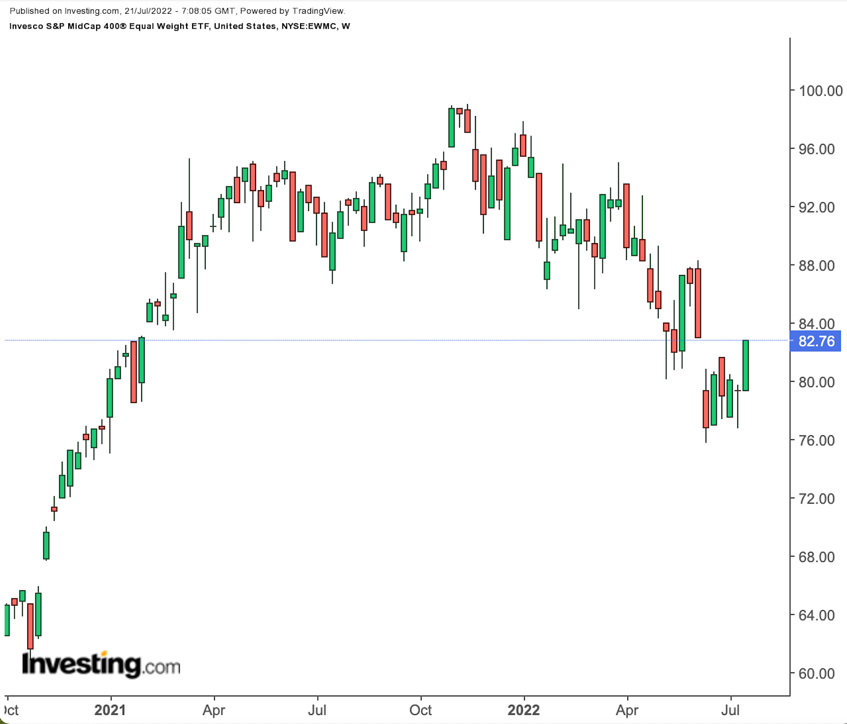- Equal-weight ETFs invest equally between all holdings
- Inherently value-based
- Can mitigate risk as diversifies based on value
- Current Price: $82.76
- 52-week range: $75.69 - $99.00
- Dividend yield: 1.20%
- Expense ratio: 0.40% per year
- Current Price: $84.52
- 52-week range: $61.78 - $136.61
- Expense ratio: 0.35% per year
- Novavax (NASDAQ:NVAX), which has been in the news for its COVID-19 vaccine.
- Precision genetic medicines developer Beam Therapeutics (NASDAQ:BEAM).
- Clinical-stage biopharma group Fate Therapeutics (NASDAQ:FATE).
- Global Blood Therapeutics Inc (NASDAQ:GBT), which has been focusing on sickle cell disease (SCD).
Wall Street is enjoying a positive week, thanks to robust reports in some of the oversold growth names. However, as the earnings season progresses, we will likely see increased volatility.
Many analysts agree that equal-weight (EQW) exchange-traded funds (ETFs) can help mitigate the risk of being over-concentrated in a handful of stocks by offering a diversified portfolio based on value.
An index or a fund with such holdings must constantly rebalance the portfolio as share prices change--thus selling high and buying low. This feature sets it apart from the traditional market capitalization (MCAP) method, where the market capitalization of each holding becomes important.
For example, the S&P 500 Equal Weighted Index, which weights members of the S&P 500 equally, has declined 14.4% since January, while the S&P 500 lost 16.9%.
Research by Solactive, which designs financial indices, suggests:
“The better returns of the EQW method are also partly explained by what we call a “rebalancing effect” – i.e., bringing stocks back to equal weight, essentially buying low and selling high – something not present in MCAP weighted portfolios….”
With that information, here are two equal-weighted ETFs to consider during this earnings season.
1. Invesco S&P MidCap 400 Equal Weight ETF
Mid-cap companies are those that typically have market capitalizations (caps) of between $2 billion and $10 billion. Most financial planners suggest long-term investors include mid-cap stocks or funds that invest in them.
Research suggests:
“Not only have mid-cap stocks generated higher absolute returns over a longer time frame, but they have also provided these returns with less associated risk.”
Mid-caps typically grow their earnings fast and also frequently become takeover targets.
The first fund we will discuss is the Invesco S&P MidCap 400 Equal Weight ETF (NYSE:EWMC). It provides to US mid-cap names. The fund started trading in December 2010, and net assets stand at 109.8 million. 
EWMC, which tracks the S&P MidCap 400 Equal Weight Index, has 402 holdings. Both the index and fund are rebalanced quarterly. With regards to sector breakdown, we see Industrials (16.97%), Consumer Discretionary (15.72%), Financials (15.29%), Information Technology (12.58%), Health Care (10.80), and others.
About 3% of the portfolio is in the top 10 stocks. Among them are Arrowhead Pharmaceuticals (NASDAQ:ARWR), retailer Ollies Bargain Outlet Holdings (NASDAQ:OLLI), restaurant group Wingstop (NASDAQ:WING), and Performance Food Group (NYSE:PFGC), which distributes food products.
EWMC hit a record high in mid-November 2021. But since then, shares in the ETF have come under pressure, and the fund is down around 14.2% YTD. Forward price-to-earnings (P/E) and price-to-book (P/B) ratios stand at 12.35x and 2.20x, respectively. Investors interested in mid-caps' growth within an EQW wrapper should research the fund further.
2. SPDR S&P Biotech ETF
The second ETF we will be discussing is the SPDR S&P Biotech ETF (NYSE:XBI) which invests primarily in the biotechnology segment of the S&P index. The fund started trading in January 2006.
XBI currently has 135 holdings where the leading 10 comprise about 15% of net assets of $7.76 billion:
Most biotechnology names have come under pressure in the past year. As a result, the fund has lost 24.5% since January and 33.9% over the past year. Trailing P/E and P/B ratios are 11.65x and 3.58x, respectively. We like the diversity of XBI and believe long-term biotech investors could consider buying it around these levels.
Disclaimer: On the date of publication, Tezcan Gecgil, Ph.D., did not have any positions in the securities mentioned in this article.
